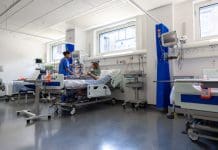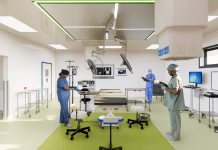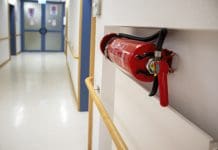Bouygues UK has completed a new £380m University College London cancer and surgery centre, incorporating a revolutionary proton beam therapy
The cancer and surgery centre also includes eight operating theatres, a surgical recovery area, a surgical ward, an imaging centre, a ten-bed critical care unit, three floors of inpatient haematology ward.
The completion of the facility marks the creation of one of Europe’s largest dedicated haemato-oncology hospitals which will provide treatment for those with complex cancers and blood disorders.
The centrepiece of the facility is a state-of-the-art proton beam therapy centre, the second of its type in the UK.
The Grafton Way building will treat 650 people with cancer and benign tumours each year, around a third of whom will be children and teenagers.
Proton beam therapy is able to deliver a highly targeted treatment that pinpoints a tumour while sparing the surrounding tissue, making it particularly beneficial for younger people as it protects IQ, general growth, and fertility.
The new building is situated in a tight site within the Bloomsbury conservation area, close to two Grade II-listed UCL buildings and London Underground lines.
The 13-storey building was designed by Scott Tallon Walker Architects in association with Edward Williams Architects, and was project managed by AECOM for UCLH.
The project has involved around 3,000 people in its construction, which included the removal of 80,000 cubic metres of earth from the site.
The proton beam therapy centre required shielding around the equipment which includes 44,000 cubic metres of concrete to form walls typically two metres thick, with areas up to five metres, reinforced with approximately 8,000 tonnes of steel.
‘Overcomes design and build challenges’
UCLH chief executive David Probert, said: “I am immensely proud of the Grafton Way Building. Delivering healthcare is the work of people, but well-designed buildings make a huge difference to how effectively this can be achieved.
“Our new Grafton Way Building overcomes design and build challenges to deliver a comforting environment for patients alongside the very latest technology and equipment for our staff. A complex building programme, made more so with the final stages taking place during the global pandemic, I congratulate everyone involved”
‘Highlighting the potential that this facility has to transform people’s lives’
Fabienne Viala, chair of Bouygues UK, commented: “We favour complex projects where we can add value through our global experience and technical expertise. This new state-of-the-art facility for UCLH is one of the most complex public building projects ever undertaken.
“Its successful delivery is a result of collaboration, both amongst Bouygues colleagues and with UCLH and the wider project team, and it’s hugely rewarding to see the first patients beginning their treatment here, highlighting the potential that this facility has to transform people’s lives.”
‘A world-class healthcare facility’
AECOM project director Sam Danquah stated: “Almost six years ago, I stood on the site of a demolished cinema and hospital at Grafton Way, envisioning how we were going to project manage the build of something larger than the Royal Albert Hall beneath my feet.
“Little did we know then the challenges that would come our way, from a global pandemic to Brexit – let alone the sheer complexity of constructing a hospital above ground and installing life-changing proton beam therapy equipment below ground.
“Through problem solving, strong governance and project controls, we met an ambitious delivery programme and budget. Seeing UCLH’s vision for a world class healthcare facility in action brings an enormous sense of pride, not just in what the delivery partners achieved through collaboration, but in what the facility can to do transform patient outcomes”
The project is a result of close collaboration between:
- University College London NHS Foundation Trust
- AECOM
- Bouygues UK
- Scott Tallon Walker
- Scott Tallon Walker in association with Edward Williams Architects
- CampbellReith
- WSP
- UCLH’s advisers also include: BDP, Arup, Curtins, Ridge, Turner and Townsend, Medical Architecture













